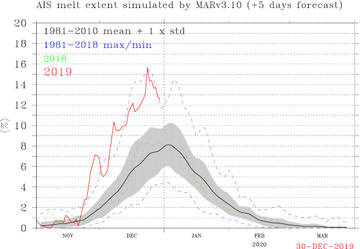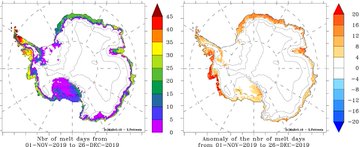RECORD
HIT FOR MOST
ICE TO MELT IN
ANTARCTICA IN ONE DAY,
DATA SUGGESTS: "WE
ARE
IN A CLIMATE
EMERGENCY"

27 December, 2019
The
record in recent decades for the highest level of ice to melt in
Antarctica in one day was reached on Christmas Eve, data suggests.
Around
15 percent of the continent's surface melted on Monday, according to
the Global Forecast System (GFS) by the National Centers for
Environmental Prediction (NCEP). The data comes from the Modèle
Atmosphérique Régional (MAR), a model used for meteorological and
climatic research.
Xavier Fettweis,
a climatologist at the University of Liège in Belgium, who tweeted
the data on Friday, said this is the highest melt extent in
Antarctica in the modern era, since 1979.
He added the
production of melt water is a record 230 percent higher than average
since November this year. That's despite the melting season not yet
being over.
"It
should be noted that this process is currently missing in most
of SMB estimations over Antarctica as melt has been
negligible until now. But the climate is changing..." Fettweis said.
Fettweis
told Newsweek Antarctica
has been "significantly warmer than average" this melting
season. But he stressed the data is from a model, and not an in situ
observation. The melting could be driven by a number of factors, and
experts will need to wait two to three melting seasons to confirm
what is going on.
"We
have observed a crash of the Antarctica polar vortex just before this
melting season," explained Fettweis, referring to low pressure
near the pole. "A weaker polar vortex allows warm air masses to
reach easier the ice sheet (which is usually protected by its polar
vortex as it was the case the previous summer). The fact that the sea
ice extent is very low also enhances the possibility of warm air
masses to reach the ice sheet."
Asked
whether climate change is to blame, he said: "As for most of the
anomalies observed on these last months over the Earth (e.g.
in Australia),
the signal coming from global warming can not be ignored here."
Fettweis
said Antarctica had been "protected" by global warming, due
in part to a stronger polar vortex over this last decade than usual.
But he said this no longer seems to be the case, and climate
anomalies observed at the continent can no longer be used by climate
skeptics to deny global warming is occurring.
Eric
Holthaus, a meteorologist and fellow at the University of Minnesota's
Institute on the Environment, shared the data on Twitter.
He
wrote: "New data indicates that on Christmas Eve, unusually warm
weather melted the most ice across the continent of Antarctica in a
single day out of any day in recorded history. 15% of the continent's
surface melted, temporarily.
"We
are in a climate emergency," said Holthaus.
The
figures come as climate change has gained
renewed public attention,
and is widely considered one of the most pressing issues of our time.
Last
month, scientists urged world leaders to take urgent action to tackle
climate change, as "abrupt" and "irreversible"
climate tipping points that threaten human civilization may
have already started.
Tipping
points are thresholds that, once passed, can trigger rapid changes to
climate systems. These were first described by the United Nations
Intergovernmental Panel on Climate Change (IPCC) two decades ago. At
that
time it was thought they would likely happen if global warming
exceeded
pre-industrial levels by 5 C. But since then, new
research has indicated the
events could happen even with 1 C to 2 C
of warming, the scientists said.
In
an article published in the journal Nature,
scientists highlighted if the likely interconnected tipping points
are met, a domino-effect of "long-term irreversible
changes"
to the planet could be triggered.
"Evidence
that tipping points are underway has mounted in the past decade,"
the experts wrote.
Antarctica
was among the regions included in the study. Evidence suggests the
Amundsen Sea embayment of West Antarctica may have already
hit a tipping
point, as the point where the ice, ocean and bedroom
meet is "retreating
irreversibly," experts wrote.
If
this area collapses, the remaining West Antarctic ice sheets could be
destabilized, "leading to about 3 meters [9.8 feet] of sea-level
rise on a timescale
of centuries to millennia," according to a
prediction cited by the authors. The
Wilkes Basin on the East
Antarctic could face a similar fate, and the Greenland
ice sheet
could be "doomed" at 1.5 C of warming as soon as 2030.
This
article has been updated with comment from Xavier Fettweis.







No comments:
Post a Comment
Note: only a member of this blog may post a comment.